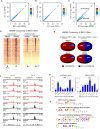Epigenetic regulation of REX1 expression and chromatin binding specificity by HMGNs
- PMID: 30838422
- PMCID: PMC6511878
- DOI: 10.1093/nar/gkz161
Epigenetic regulation of REX1 expression and chromatin binding specificity by HMGNs
Abstract
HMGN proteins localize to chromatin regulatory sites and modulate the cell-type specific transcription profile; however, the molecular mechanism whereby these ubiquitous nucleosome binding proteins affect gene expression is not fully understood. Here, we show that HMGNs regulate the expression of Rex1, one of the most highly transcribed genes in mouse embryonic stem cells (ESCs), by recruiting the transcription factors NANOG, OCT4 and SOX2 to an ESC-specific super enhancer located in the 5' region of Rex1. HMGNs facilitate the establishment of an epigenetic landscape characteristic of active chromatin and enhancer promoter interactions, as seen by chromatin conformation capture. Loss of HMGNs alters the local epigenetic profile, increases histone H1 occupancy, decreases transcription factors binding and reduces enhancer promoter interactions, thereby downregulating, but not abolishing Rex1 expression. ChIP-seq analyses show high colocalization of HMGNs and of REX1, a zinc finger protein, at promoters and enhancers. Loss of HMGNs preferentially reduces the specific binding of REX1 to these chromatin regulatory sites. Thus, HMGNs affects both the expression and the chromatin binding specificity of REX1. We suggest that HMGNs affect cell-type specific gene expression by modulating the binding specificity of transcription factors to chromatin.
Published by Oxford University Press on behalf of Nucleic Acids Research 2019.
Figures







Similar articles
-
H3K27ac nucleosomes facilitate HMGN localization at regulatory sites to modulate chromatin binding of transcription factors.Commun Biol. 2022 Feb 23;5(1):159. doi: 10.1038/s42003-022-03099-0. Commun Biol. 2022. PMID: 35197580 Free PMC article.
-
HMGN proteins modulate chromatin regulatory sites and gene expression during activation of naïve B cells.Nucleic Acids Res. 2016 Sep 6;44(15):7144-58. doi: 10.1093/nar/gkw323. Epub 2016 Apr 25. Nucleic Acids Res. 2016. PMID: 27112571 Free PMC article.
-
Interplay between H1 and HMGN epigenetically regulates OLIG1&2 expression and oligodendrocyte differentiation.Nucleic Acids Res. 2017 Apr 7;45(6):3031-3045. doi: 10.1093/nar/gkw1222. Nucleic Acids Res. 2017. PMID: 27923998 Free PMC article.
-
HMGNs: The enhancer charmers.Bioessays. 2016 Mar;38(3):226-31. doi: 10.1002/bies.201500157. Epub 2015 Dec 28. Bioessays. 2016. PMID: 26709929 Review.
-
Regulation of chromatin structure and function by HMGN proteins.Biochim Biophys Acta. 2010 Jan-Feb;1799(1-2):62-8. doi: 10.1016/j.bbagrm.2009.11.016. Epub 2009 Nov 27. Biochim Biophys Acta. 2010. PMID: 19948260 Free PMC article. Review.
Cited by
-
AKT signaling is associated with epigenetic reprogramming via the upregulation of TET and its cofactor, alpha-ketoglutarate during iPSC generation.Stem Cell Res Ther. 2021 Sep 25;12(1):510. doi: 10.1186/s13287-021-02578-1. Stem Cell Res Ther. 2021. PMID: 34563253 Free PMC article.
-
KLF4 is involved in the organization and regulation of pluripotency-associated three-dimensional enhancer networks.Nat Cell Biol. 2019 Oct;21(10):1179-1190. doi: 10.1038/s41556-019-0390-6. Epub 2019 Sep 23. Nat Cell Biol. 2019. PMID: 31548608 Free PMC article.
-
Spatial and Temporal Expression of High-Mobility-Group Nucleosome-Binding (HMGN) Genes in Brain Areas Associated with Cognition in Individuals with Down Syndrome.Genes (Basel). 2021 Dec 17;12(12):2000. doi: 10.3390/genes12122000. Genes (Basel). 2021. PMID: 34946949 Free PMC article.
-
CFIm25 regulates human stem cell function independently of its role in mRNA alternative polyadenylation.RNA Biol. 2022;19(1):686-702. doi: 10.1080/15476286.2022.2071025. Epub 2021 Dec 31. RNA Biol. 2022. PMID: 35491945 Free PMC article.
-
Multiple epigenetic factors co-localize with HMGN proteins in A-compartment chromatin.Epigenetics Chromatin. 2022 Jun 27;15(1):23. doi: 10.1186/s13072-022-00457-4. Epigenetics Chromatin. 2022. PMID: 35761366 Free PMC article.
References
-
- Izzo A., Schneider R.. The role of linker histone H1 modifications in the regulation of gene expression and chromatin dynamics. Biochim. Biophys. Acta. 2016; 1859:486–495. - PubMed
Publication types
MeSH terms
Substances
LinkOut - more resources
Full Text Sources
Research Materials

